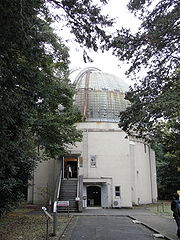
National Astronomical Observatory of Japan
Encyclopedia
The is an astronomical
research organisation comprising several facilities in Japan
, as well as an observatory in Hawaii
. It was established in 1988 as an amalgamation of three existing research organizations - the Tokyo Astronomical Observatory of the University of Tokyo
, International Latitude Observatory of Mizusawa, and a part of Research Institute of Atmospherics of Nagoya University
.
In the 2004 reform of national research organizations, NAOJ became a division of the National Institutes of Natural Sciences
.



 Mitaka Campus (Mitaka, Tokyo
Mitaka Campus (Mitaka, Tokyo
. 35.6752172°N 139.5380831°W)
Nobeyama Radio Observatory & Nobeyama Solar Radio Observatory (Minamimaki, Nagano
, 35.9410112°N 138.4702528°W)
Mizusawa VERA Observatory (Ōshū, Iwate
. 39.1350952°N 141.1332035°W)
Norikura Solar Observatory (Mt. Norikura, Nagano
, 36.116925°N 137.552528°W)
Okayama Astrophysical Observatory (Mt. Chikurinji, Okayama
. 34.5760726°N 133.5941148°W)
VERA 20m radio telescopes
Hawaii Observatory (Hawaii
)
, the National Institute for Fusion Science, the National Institute for Physiological Sciences, and the Institute for Molecular Science - established the National Institutes of Natural Sciences (NINS)
to promote collaboration among researchers of the five constituent institutes.
Astronomy
Astronomy is a natural science that deals with the study of celestial objects and phenomena that originate outside the atmosphere of Earth...
research organisation comprising several facilities in Japan
Japan
Japan is an island nation in East Asia. Located in the Pacific Ocean, it lies to the east of the Sea of Japan, China, North Korea, South Korea and Russia, stretching from the Sea of Okhotsk in the north to the East China Sea and Taiwan in the south...
, as well as an observatory in Hawaii
Hawaii
Hawaii is the newest of the 50 U.S. states , and is the only U.S. state made up entirely of islands. It is the northernmost island group in Polynesia, occupying most of an archipelago in the central Pacific Ocean, southwest of the continental United States, southeast of Japan, and northeast of...
. It was established in 1988 as an amalgamation of three existing research organizations - the Tokyo Astronomical Observatory of the University of Tokyo
University of Tokyo
, abbreviated as , is a major research university located in Tokyo, Japan. The University has 10 faculties with a total of around 30,000 students, 2,100 of whom are foreign. Its five campuses are in Hongō, Komaba, Kashiwa, Shirokane and Nakano. It is considered to be the most prestigious university...
, International Latitude Observatory of Mizusawa, and a part of Research Institute of Atmospherics of Nagoya University
Nagoya University
Nagoya University is one of the most prestigious universities in Japan. It can be seen in the several rankings such as shown below.-General Rankings:...
.
In the 2004 reform of national research organizations, NAOJ became a division of the National Institutes of Natural Sciences
National Institutes of Natural Sciences, Japan
The is an inter-university research institute corporation consisting of five member institutes: the National Astronomical Observatory , the National Institute for fusion Science , the National Institute for Basic Biology , the National Institute for Physiological Sciences , and the Institutes for...
.
Facilities




Mitaka, Tokyo
is a city located in Tokyo, Japan. As of 1 November 2010, the city has an estimated population of 176,737. The total area is 16.50 km² and is about 50 – 55 meters above sea level...
. 35.6752172°N 139.5380831°W)
- The Headquarters, Astronomy Data Center, Advanced Technology Center, Public Relations Center
- Solar Flare Telescope, Sunspot Telescope, TAMA 300TAMA 300TAMA 300 is a gravitational wave detector located at the Mitaka campus of the National Astronomical Observatory of Japan. It is a project of the gravitational wave studies group at the Institute for Cosmic Ray Research of the University of Tokyo...
gravitational wave detectorGravitational wave detectorA gravitational wave detector is any experiment designed to measure gravitational waves, minute distortions of spacetime that are predicted by Einstein's theory of general relativity. The existence of gravitational radiation is a prediction of Einstein's general theory of relativity. Gravitational... - Tokyo Photoelectric Meridian CircleTokyo Photoelectric Meridian CircleThe Tokyo Photoelectric Meridian Circle is a meridian circle that observes and records the positions of stars and planets, which are then reported in the PMC catalogs.-Meridian circle:...
- Historical instruments: Solar Tower Telescope, 65cm refractor dome, 20cm refractor dome
Nobeyama Radio Observatory & Nobeyama Solar Radio Observatory (Minamimaki, Nagano
Minamimaki, Nagano
is a village located in Minamisaku District, Nagano, Japan.As of 2003, the village has an estimated population of 3,490 and a density of 26.22 persons per km². The total area is 133.10 km².-External links:*...
, 35.9410112°N 138.4702528°W)
- 45m Millimeter Radio Telescope, Nobeyama Millimeter Array, Nobeyama Radio Heliograph
Mizusawa VERA Observatory (Ōshū, Iwate
Oshu, Iwate
is the second largest city in Iwate Prefecture, Japan with a population of 127,804.The city was founded on February 20, 2006, as the result of a merger between the cities of Esashi and Mizusawa, the towns of Maesawa and Isawa and the village of Koromogawa from Isawa District...
. 39.1350952°N 141.1332035°W)
- 20m radio telescope, 10m VLBI radio telescope
- Historical building: Dr. Kimura Museum
Norikura Solar Observatory (Mt. Norikura, Nagano
Nagano Prefecture
is a prefecture of Japan located in the Chūbu region of the island of Honshū. The capital is the city of Nagano.- History :Nagano was formerly known as the province of Shinano...
, 36.116925°N 137.552528°W)
- 10cm Coronagraph, 25cm Coronagraph
Okayama Astrophysical Observatory (Mt. Chikurinji, Okayama
Okayama Prefecture
is a prefecture of Japan located in the Chūgoku region on Honshū island. The capital is the city of Okayama.- History :During the Meiji Restoration, the area of Okayama Prefecture was known as Bitchū Province, Bizen Province and Mimasaka Province.- Geography :...
. 34.5760726°N 133.5941148°W)
- 188cm telescope, 91cm telescope, 65cm Coude-Type solar telescope
VERA 20m radio telescopes
- Mizusawa
- OgasawaraChichi-jima, formerly known as Peel Island and in the 19th century known to the English as part of the Bonin Islands, is the largest island in the Ogasawara archipelago. Chichi-jima is approximately 150 miles north of Iwo Jima. The island is within the political boundaries of Ogasawara Town, Ogasawara...
. 27°05′30"N 142°13′00"E - IrikiSatsumasendai, Kagoshimais a city located in Kagoshima, Japan. It was established on October 12, 2004 with the merger of the city of Sendai, Kagoshima, the towns of Hiwaki, Iriki, Kedōin and Tōgō, and Koshikijima Islands , all from Satsuma District.As of January 1, 2008, the city had an estimated population of 100,730 in...
. 31.7478213°N 130.4399443°W - IshigakijimaIshigaki, OkinawaIshigaki is an island west of Okinawa Hontō and the second-largest island of the Yaeyama Island group. It is within the City of Ishigaki in Okinawa Prefecture. The city functions as the business and transport center of the archipelago...
. 24°24′43.834"N 124°10′15.578"E
Hawaii Observatory (Hawaii
Hawaii (island)
The Island of Hawaii, also called the Big Island or Hawaii Island , is a volcanic island in the North Pacific Ocean...
)
- SubaruSubaru (telescope)Subaru Telescope is the 8.2 metre flagship telescope of the National Astronomical Observatory of Japan, located at the Mauna Kea Observatory on Hawaii. It is named after the open star cluster known in English as the Pleiades...
8m telescope (Mt. Mauna KeaMauna KeaMauna Kea is a volcano on the island of Hawaii. Standing above sea level, its peak is the highest point in the state of Hawaii. However, much of the mountain is under water; when measured from its oceanic base, Mauna Kea is over tall—significantly taller than Mount Everest...
. 19.825814°N 155.476455°W) - Hilo Base Facility (Hilo, Hawaii. 19.70289°N 155.0902498°W)
NINS
In 2004, NAOJ, in alliance with four other national institutes - the National Institute for Basic BiologyNational Institute for Basic Biology, Japan
The is a research institute and post graduate university in Okazaki City, Aichi Prefecture, Japan. NIBB was founded in 1977 to promote biological research in Japan in cooperation with public and private universities, and research institutes.-Research:...
, the National Institute for Fusion Science, the National Institute for Physiological Sciences, and the Institute for Molecular Science - established the National Institutes of Natural Sciences (NINS)
National Institutes of Natural Sciences, Japan
The is an inter-university research institute corporation consisting of five member institutes: the National Astronomical Observatory , the National Institute for fusion Science , the National Institute for Basic Biology , the National Institute for Physiological Sciences , and the Institutes for...
to promote collaboration among researchers of the five constituent institutes.
Projects with NAOJ involvement
- ALMAALMAALMA can refer to* ALMA Award, a distinction awarded to Latino performers who promote positive portrayals of Latinos in the entertainment field.* ALMA Magazine, a Spanish-language lifestyle magazine....
, ASTEAtacama Submillimeter Telescope ExperimentThe Atacama Submillimeter Telescope Experiment is a 10m antenna built by Mitsubishi Electric as a preprototype for ALMA.The ASTE was deployed to its site on Pampa La Bola, near Cerro Chajnantor and the Llano de Chajnantor Observatory in northern Chile. The antenna shows excellent performance... - SELENESELENESELENE , better known in Japan by its nickname after the legendary Japanese moon princess, was the second Japanese lunar orbiter spacecraft. Produced by the Institute of Space and Astronautical Science and the National Space Development Agency , both now part of the Japan Aerospace Exploration...
- VSOPHALCAThe HALCA , also known for its project name VSOP , or the code name MUSES-B for the second of the Mu Space Engineering Spacecraft series, is a Japanese 8 meter diameter radio telescope satellite which was used for Very Long Baseline Interferometry...
, VSOP-2ASTRO-GAstro-G is a planned radio telescope satellite under development by JAXA. It is expected to be launched into elliptic orbit around Earth . Astro-G was selected in February 2006 against the competition of a proposed new X-Ray astronomy mission and a proposed solar sail mission to Jupiter... - Hinode (Solar-B)HinodeHinode , formerly Solar-B, is a Japan Aerospace Exploration Agency Solar mission with United States and United Kingdom collaboration. It is the follow-up to the Yohkoh mission and it was launched on the final flight of the M-V-7 rocket from Uchinoura Space Center, Japan on 22 September 2006 at...
- SPICA (satellite)
- JASMINEJasmine (disambiguation)-Botany:"Jasmine" is the misnomer of several other plants not actually related to the true jasmine, including*Trachelospermum, Star jasmine*Gardenia, Cape jasmine*Gelsemium, Carolina Jasmine*Tree Jasmine...
- Hubble Origins ProbeHubble Origins ProbeThe Hubble Origins Probe is an orbital telescope proposed by an international team led by Johns Hopkins University astronomers. The proposed telescope would make use of designs from the Hubble Space Telescope , and instruments that were intended for the planned 4th HST servicing mission, as well...
See also
- List of astronomical observatories
- National Institutes of Natural Sciences, JapanNational Institutes of Natural Sciences, JapanThe is an inter-university research institute corporation consisting of five member institutes: the National Astronomical Observatory , the National Institute for fusion Science , the National Institute for Basic Biology , the National Institute for Physiological Sciences , and the Institutes for...

